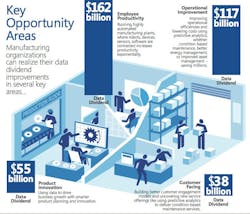If there’s one common theme I see and hear repeated in presentations and articles about the Internet of Things (IoT) and the value it can have to manufacturing, it’s that the technologies to enable the IoT are here today—and typically already in place at most manufacturing facilities. If that’s the case, why is that the IoT concept is typically treated like a futuristic, utopian manufacturing scenario that is all too easily dismissed?
That’s a hard question to answer to everyone’s satisfaction, but it’s most likely due to the grandiose application possibilities that are typically part of most IoT discussions. But when you dispense with the awe-inspiring application theories and take a small slice of the IoT concept, it becomes much more understandable and tangible.
To foster the IoT concept in a more easily digestible way, Microsoft recently sponsored an IDC study of global companies to better understand what actions by “data smart” manufacturing organizations yield the most impactful outcomes—both in terms of growth and efficiency. (See the article What is a Data Smart Manufacturer? for an explanation of what Microsoft means by the term “data smart”.) The research revealed what IDC and Microsoft claim is a $371 billion potential global net value that could be attained over four years via data smart manufacturing. This “data dividend”, as Microsoft refers to it, can be achieved by companies that become data smart and perform some combination of the following four actions: a) bring together as few as three to four discrete data sources, b) use analytics tools to glean insights from the data, c) surface those insights in a consumable fashion to the right decision makers across the company, and d) ensure that insights from data are shared in a timely manner.
According to Microsoft, manufacturing organizations that take all four of these steps stand to realize a 60 percent greater return on their data assets. The research also revealed that productivity and operations are two areas with the largest data dividend gains.
Dan Vesset, program vice president covering business analytics and big data at IDC, said that the $371 billion data dividend was based on review of manufacturing industry respondents revenue gains and cost controls achieved from recent data-centered projects and projected out four years around expected IT spending on data and analytics.
He added that, though becoming a data smart manufacturing involves fairly straightforward steps, it is “not a trivial task.” It can be a highly complex project for a manufacturer, but the opportunity in revenue gains and cost controls are proving to be worth the effort, he said.
Vesset pointed to examples of data smart strategies deployed today that are yielding “early but impressive returns across the high-value areas identified in the IDC study, such as employee productivity, operational efficiency, product innovation and better customer engagement models.” Two of the examples he references include:
• A factory that manufactures the Jeep Wrangler car body which, by using data smart approaches, can build a car body every 77 seconds; and
• M.G. Bryan, a heavy equipment manufacturer, which uses the cloud to analyze data for predictive maintenance (see video explaining how M.G. Bryan does this at the bottom of this article).
Even with the realization that harnessing IoT and big data to become a data smart manufacturer is not, necessarily, the most complex task ever, it is a journey of thousands of steps which can only be started by taking the first step. And that’s where many manufacturers get stuck … deciding what to do first or how to do it. Fortunately, there’s lots of information out there to help. Microsoft, for one, has recently launched a site focused on helping companies take the first step with this. Considering that use of the Microsoft OS and associated applications is fairly ubiquitous across most manufacturing sites, and that all of the major automation suppliers are Microsoft partners to one degree or another, this site is worth a look.
The video below explains how M.G. Bryan, a heavy equipment oil and gas OEM, uses Microsoft Azure Cloud and Rockwell Automation products to be a data smart manufacturer.

